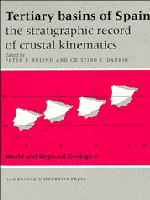Book contents
- Frontmatter
- Contents
- List of contributors
- Preface
- Dedication to Professor Oriol Riba IArderiu
- Memorial, Etienne Moissenet 1941–1994
- PART G GENERAL
- PART E EAST
- PART W WEST
- PART C CENTRE
- C1 Structure and Tertiary evolution of the Madrid basin
- C2 Neogene tectono-sedimentary review of the Madrid basin
- C3 Sedimentary evolution of lake systems through the Miocene of the Madrid Basin: paleoclimatic and paleohydrological constraints
- C4 Paleomorphologic features of an intra-Vallesian paleokarst, Tertiary Madrid Basin: significance of paleokarstic surfaces in continental basin analysis
- C5 Tectono-sedimentary analysis of the Loranca Basin (Upper Oligocene–Miocene, Central Spain): a ‘non-sequenced’ foreland basin
- C6 Paleoecology and paleoclimatology of micromammal faunas from Upper Oligocene – Lower Miocene sediments in the Loranca Basin, Province of Cuenca, Spain
- C7 Fluvial fans of the Loranca Basin, Late Oligocene – Early Miocene, central Spain
- C8 Saline deposits associated with fluvial fans, Late Oligocene – Early Miocene, Loranca Basin, Central Spain
- C9 Shallow carbonate lacustrine depositional controls during the Late Oligocene – Early Miocene in the Loranca Basin (Cuenca Province, central Spain)
- PART S SOUTH
- Index
C5 - Tectono-sedimentary analysis of the Loranca Basin (Upper Oligocene–Miocene, Central Spain): a ‘non-sequenced’ foreland basin
Published online by Cambridge University Press: 04 August 2010
- Frontmatter
- Contents
- List of contributors
- Preface
- Dedication to Professor Oriol Riba IArderiu
- Memorial, Etienne Moissenet 1941–1994
- PART G GENERAL
- PART E EAST
- PART W WEST
- PART C CENTRE
- C1 Structure and Tertiary evolution of the Madrid basin
- C2 Neogene tectono-sedimentary review of the Madrid basin
- C3 Sedimentary evolution of lake systems through the Miocene of the Madrid Basin: paleoclimatic and paleohydrological constraints
- C4 Paleomorphologic features of an intra-Vallesian paleokarst, Tertiary Madrid Basin: significance of paleokarstic surfaces in continental basin analysis
- C5 Tectono-sedimentary analysis of the Loranca Basin (Upper Oligocene–Miocene, Central Spain): a ‘non-sequenced’ foreland basin
- C6 Paleoecology and paleoclimatology of micromammal faunas from Upper Oligocene – Lower Miocene sediments in the Loranca Basin, Province of Cuenca, Spain
- C7 Fluvial fans of the Loranca Basin, Late Oligocene – Early Miocene, central Spain
- C8 Saline deposits associated with fluvial fans, Late Oligocene – Early Miocene, Loranca Basin, Central Spain
- C9 Shallow carbonate lacustrine depositional controls during the Late Oligocene – Early Miocene in the Loranca Basin (Cuenca Province, central Spain)
- PART S SOUTH
- Index
Summary
Abstract
The western margin of the Loranca Basin is the Sierra Altomira, which separates it from the Madrid Basin. The eastern margin is formed by the Iberian Range, which supplied most of the Tertiary continental sediment that fills the Loranca Basin. This basin fill is divided into five units (I to V), ranging from Middle Eocene to Late Miocene in age. The tectonic and sedimentary evolution of the Basin has been analysed using outcrop and seismic mapping of the units and their folding, faulting and unconformities.
Introduction
The Loranca Basin, located in Central Spain, is separated from the Madrid Basin by the Sierra Altomira and bounded to the east by the Iberian Range (Fig. 1). The basin was filled by pre-and synorogenic Tertiary continental sediments, mainly sourced from the Iberian Range fold and thrust belt, which acted as the main active foreland.
The general stratigraphy of the Loranca Basin has been described by several authors (Vilas-Minondo & Pérez González, 1971; Meléndez Hevia, 1971; Viallard, 1973; Díaz-Molina, 1974; Garcia-Abbad, 1975; Díaz-Molina & López-Martinez, 1979; Díaz-Molina et al., 1985, 1989; Torres & Zapata, 1986-1987a, b; Torres et al., 1992).
Knowledge of the surface geology of the basin has been improved in the last few years by extensive regional mapping by ITGE. The results of this work have been reviewed and compiled in Fig. 2.
- Type
- Chapter
- Information
- Tertiary Basins of SpainThe Stratigraphic Record of Crustal Kinematics, pp. 285 - 294Publisher: Cambridge University PressPrint publication year: 1996
- 8
- Cited by



